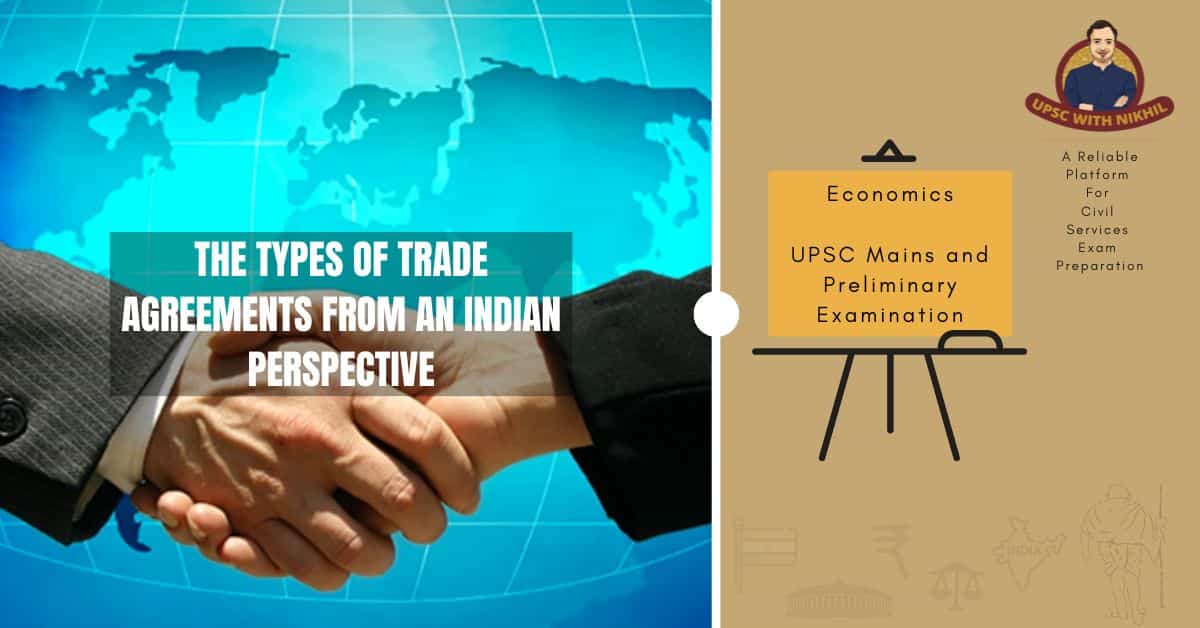The Types Of Trade Agreements From An Indian Perspective
An agreement for trade, commerce, transit, or investment between two or more nations is referred to as a trade agreement. They mainly entail concessions that are advantageous to both parties.
There are various different kinds of trade agreements, depending on the conditions and concessions agreed upon by the involved parties.
Free Trade Agreement
A free trade agreement is one in which two or more nations concur to grant the partner nation favorable trading conditions, tariff concessions, etc. It is more extensive than a preferential trade agreement because the negotiating nations maintain a list of goods and services for which the FTA's rules do not apply. India has signed free trade agreements (FTA) with numerous nations, including Sri Lanka, and with a number of economic blocs, including ASEAN.
Preferential Trade Agreement
In this kind of arrangement, two or more partners grant specific products preferred entrance. This is accomplished by lowering taxes on a predetermined number of tariff lines. In this case, a positive list—a list of the products for which the two parties have agreed to grant preferred access—is kept. Potentially in a PTA, some products' tariffs could even be eliminated. Afghanistan and India have a PTA.
Agreement For A Comprehensive Economic Partnership
An FTA is not as extensive as a partnership or cooperation arrangement. The regulatory element of trade is another area that CECA/CEPA examines and includes a regulatory agreement. Having the most coverage is CECA. CEPA covers negotiations on investment, trade in services, and other economic partnership areas. It may even take into account negotiating in areas like IPR, competition, and customs cooperation for trade facilitation.
India has CEPAs with Japan and South Korea.
Agreement On Global Economic Cooperation
Only trade tariff and TQR rate negotiations are typically covered by CECA. It falls short of CEPA's breadth. With Malaysia, India has signed the CECA.
Framework Agreement
The scope and orientation of the proposed agreement between the trading partners are principally defined in a framework agreement. It offers a few fresh debate points and establishes the time frame for future liberalization. India and the ASEAN, Japan, and other countries have previously inked framework agreements.
Early Harvest Initiative (Scheme)
An FTA/CECA/CEPA is a step before an Early Harvest Scheme (EHS) between two trading partners. For instance, the RCEP's early harvest programme has been implemented. Prior to the conclusion of formal FTA discussions, the negotiating parties nominate specific products for tariff liberalization. An Early Harvest Program is a step in the direction of increased engagement and confidence development.
Global System Of Trade Preferences (Gstp)
Tariff concessions are traded between developing nations that have signed the agreement creating the GSTP. The GSTP now has 46 members, and India has negotiated minor tariff discounts on a few products with 12 other nations. The only organization permitted to issue Certificates of Origin under the GSTP is EIC. Eight nations participated in the GSTP Sao Paulo Round, however as of October 2014, only Cuba, India and Malaysia had ratified the Protocol.
The following nations are a part of the Global System of Trade Preferences (GSTP): Algeria, Argentina, Bangladesh, Benin, Bolivia, Brazil, Cameroon, Chile, Colombia, Cuba, Democratic People's Republic of Korea, Ecuador, Egypt, Ghana, Guinea, Guyana, India, Indonesia, Iran, Iraq, Libya, Malaysia, Mexico, Morocco, Mozambique, Myanmar, Nicaragua, Nigeria, Pakistan, Peru, Philippines, Republic of Korea, Romania, Singapore, Sri Lanka, Sudan, Thailand, Trinidad.
Asia-Pacific Trade Agreement (Apta)
The Economic and Social Commission for Asia and the Pacific (ESCAP) region's commerce in products will be gradually liberalized and expanded through the APTA by lowering tariff and nontariff obstacles. Under the terms of APTA, Bangladesh, Sri Lanka, South Korea, India, and China are now exchanging tariff concessions. Mongolia joined APTA during the 43rd Standing Session in May 2014. It is the only PTA that exists between China and India.
The Asia Pacific Trade Agreement (APTA) is a trade agreement between Bangladesh, China, India, Lao People's Democratic Republic, Republic of Korea, and Sri Lanka.
Mercosur-India Pta
The PTA between India and MERCOSUR includes five Annexes. South American nations form the MERCOSUR economic bloc. Argentina, Brazil, Paraguay, Uruguay, and Venezuela are its members. In 2005, India and MERCOSUR completed the PTA on the sidelines of the G-20. The PTA broadly addresses 5 areas. - offers list of MERCOSUR countries willing to reduce tariffs on Indian items sold in MERCOSUR and vice versa.
While the MERCOSUR offer list for concession includes 450 products, the Indian offer list for concession in India comprises 450 products. Dispute resolution procedures, safeguard measures, and rules of origin are all covered in the PTA (DSP). Meat and meat products, organic and inorganic chemicals, dyes and pigments, raw hides and skins, leather goods, wool, cotton yarn, glass and glassware, iron and steel items, machinery items, electrical machinery and equipment, and optical, photographic, and cinematographic apparatus are the main items covered in the Indian offer list.
Food preparations, organic chemicals, pharmaceuticals, essential oils, plastics & articles, rubber and rubber goods, tools & implements, mechanical items, electrical machinery & equipment, and rubber are the main product groupings covered in the MERCOSUR offer list. The India-MERCOSUR PTA went into force on June 1st, 2009.



